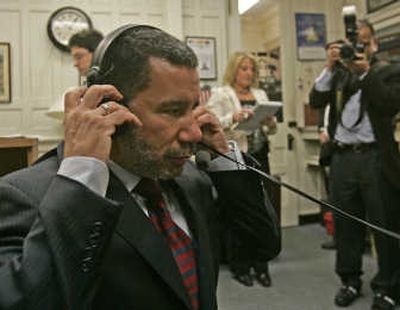Despite progress, the blind still find bias

NEW YORK – Technology and training have improved to the point that blind people can adeptly perform a array of jobs – including the governorship of New York. The biggest obstacle still in their way, advocates say, is the negative attitude of many employers. The most recent available statistics suggest that only about 30 percent of working-age blind people have jobs. That figure was calculated more than 10 years ago, but the major groups lobbying on behalf of blind Americans believe it remains accurate despite numerous technological advances.
“Most people don’t know a blind person, so they assume that blind people are not capable of doing most jobs when in fact that’s not true,” said Chris Danielsen, spokesman for the National Federation of the Blind.
Exhibit A, for the moment, is David Paterson, the legally blind lieutenant governor of New York from Harlem who was sworn in Monday as governor, replacing scandal-tarnished Eliot Spitzer.
“Unfortunately, we’re still living in an age of misperceptions of what blind people can do,” said Carl Augusto, president of the American Foundation for the Blind. “We’re hoping that an employer considering hiring a blind person will say that if David Paterson can be governor and be legally blind, maybe this applicant who is blind can be a good computer programmer.”
There are an estimated 10 million visually impaired people in the United States, including about 1.3 million who are legally blind, according to Augusto’s foundation. The foundation says legal blindness is generally described as visual acuity of 20-200 or less in the better eye, with a corrective lens. Paterson has enough sight in his right eye to walk unaided, recognize people at conversational distance and read if the text is close to his face.
In theory, those people are covered by the Americans with Disabilities Act, which among its many provisions requires employers to give fair consideration and treatment to visually impaired employees and job applicants. But Augusto said employers routinely turn down blind applicants.
“The ADA is a wonderful law, but many employers find a way not to seriously consider blind people,” he said. “They look at themselves and then say, ‘I can’t imagine how a blind person can be a computer programmer. They can’t possibly do it.’ “
Advocacy groups work to change such attitudes by using employer education programs and public appearances by successful blind people to discuss their capabilities. One component of such campaigns is to raise awareness of the ever-evolving technology that helps blind people handle more types of jobs – including software that reads aloud information on a computer screen and scanners that can covert printed material into Braille or an accessible electronic format.
“The assisted technology has made the playing field as level as it’s ever been for blind people,” said Kirk Adams, president of Seattle’s Lighthouse for the Blind, a nonprofit agency that provides job help. “There are fewer and fewer jobs a blind person can’t do.”
Adams, 46, said being blind seemed a hindrance when he first began post-college job hunting, but he was hired as a securities broker and later served in various nonprofit fundraising jobs before moving to Lighthouse, which has 190 blind people on its payroll.
One problem he notes is the difficulty many young blind people face in getting short-term or part-time work during high school and college.
“There’s a real divergence with sighted kids,” Adams said. “It’s very typical that a blind kid at 16 or 18 is not having success finding that first employment – we see a lot of frustration around that age because employers may not be thinking about making those short-term jobs accessible.”
The American Foundation for the Blind says its latest research indicates that once young blind people complete top-notch training and education programs, they attain an employment rate not much lower than sighted people. But Augusto said the overall portion of blind people with jobs remains low because many older workers who lose vision in middle age drop out of the work force rather than undergo retraining.
The Equal Employment Opportunity Commission, which tracks workplace discrimination cases covered by the Americans with Disabilities Act, says 455 such complaints were filed last year by visually impaired workers – the highest number since 1995.